|
Getting your Trinity Audio player ready...
|
 By Nicky Rehbock
By Nicky Rehbock
One of the dominant themes of the 15th Anti-Corruption Conference in Brasilia was the role of civil society in fighting corruption. Simply put, civil society is a space outside one’s family, state or economy where people can group together to support action on a set of issues. Corruption Watch was sponsored a place at the conference and was able to chat to Chris Doig of India’s I Paid a Bribe website.
Within the sphere of civil society, a host of easily accessible online tools are developing that are changing the way corruption is perceived and dealt with. With the average citizen in the developing world gaining increasing access to these technologies, the process of fighting corruption is becoming democratised – that is, it’s being taken away from the hands of a powerful few and given to those who are most affected.
See a video about some of these tools here.
India’s I Paid a Bribe
But this is a lot of theoretical talk. The best way to delve deeper into the subject is to give a practical example. Chris Doig of the Janaagraha Centre for Citizenship and Democracy in India, was able to give some insight on the online platform he works with in India, I Paid a Bribe.
Doig refers to the type of incidents reported on this portal as “retail corruption”.
“This is the kind of corruption that confronts ordinary citizens in their daily lives when they try to access government services to which they are legitimately entitled – getting a driver’s license, a birth certificate, registering a purchase of property,” he said.
The online facility uses a crowd-sourcing model to receive the public’s reports and displays them online in an anonymous, visually appealing way to expose hotspots and trends.
The website content includes confessionals, stories from bribe fighters and those that celebrate the good guys in the system. It also provides a platform where people can post and share ideas on how to avoid bribery.
Launched in August 2010, the site has received 1.3-million hits and 21 497 reports of retail corruption from 488 cities around the country. The worth of the corruption reported nears US$11-million.
Some of the successes of the I Paid a Bribe initiative have resulted in action being taken against public officials implicated in the reports.
One example is a “systemic breakthrough” at Bangalore’s traffic department.
“Upon receipt of a report, the traffic commissioner of Bangalore communicated his embarrassment when he found out his department had the highest rate of bribe-taking in Bangalore. I Paid a Bribe worked with him and his senior management team to re-engineer the process flow, and reduce the loopholes in bribery in the area of issuing drivers’ licenses. This involved automating two key steps that, in the past, had experienced a great deal of personal discretion.”
Image

Excerpt
Corruption Watch interviewed Chris Doig of India’s I Paid a Bribe website who shared insights into how online platforms can be used in the fight against corruption.
File Upload


